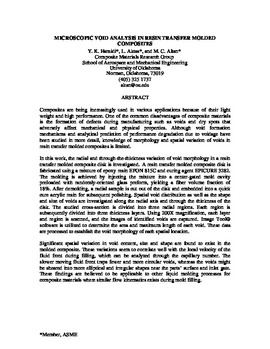| dc.contributor.author | Hamidi, Y. K. | |
| dc.contributor.author | Aktas, L. | |
| dc.contributor.author | Altan, M. C. | |
| dc.date.accessioned | 2016-03-23T23:36:11Z | |
| dc.date.accessioned | 2016-03-30T15:35:41Z | |
| dc.date.available | 2016-03-23T23:36:11Z | |
| dc.date.available | 2016-03-30T15:35:41Z | |
| dc.date.issued | 2003 | |
| dc.identifier.citation | Hamidi, Y. K., Aktas, L and Altan, M. C. Microscopic Void Analysis in Resin Transfer Molded Composites, Presented at the 23rd Oklahoma AIAA/ASME Symposium, 2003. | en_US |
| dc.identifier.uri | https://hdl.handle.net/11244/33179 | |
| dc.description.abstract | Composites are being increasingly used in various applications because of their light weight and high performance. One of the common disadvantages of composite materials is the formation of defects during manufacturing such as voids and dry spots that adversely affect mechanical and physical properties. Although void formation mechanisms and analytical prediction of performance degradation due to voidage have been studied in more detail, knowledge of morphology and spatial variation of voids in resin transfer molded composites is limited.
In this work, the radial and through-the-thickness variation of void morphology in a resin transfer molded composite disk is investigated. A resin transfer molded composite disk is fabricated using a mixture of epoxy resin EPON 815C and curing agent EPICURE 3282. The molding is achieved by injecting the mixture into a center-gated mold cavity preloaded with randomly-oriented glass preform, yielding a fiber volume fraction of 18%. After demolding, a radial sample is cut out of the disk and embedded into a quick cure acrylic resin for subsequent polishing. Spatial void distribution as well as the shape and size of voids are investigated along the radial axis and through the thickness of the disk. The studied cross-section is divided into three radial regions. Each region is subsequently divided into three thickness layers. Using 200X magnification, each layer and region is scanned, and the images of identified voids are captured. Image Tool® software is utilized to determine the area and maximum length of each void. These data are processed to establish the void morphology of each spatial location.
Significant spatial variation in void content, size and shape are found to exist in the molded composite. These variations seem to correlate well with the local velocity of the fluid front during filling, which can be analyzed through the capillary number. The slower moving fluid front traps fewer and more circular voids, whereas the voids might be sheared into more elliptical and irregular shapes near the parts’ surface and inlet gate. These findings are believed to be applicable to other liquid molding processes for composite materials where similar flow kinematics exists during mold filling. | en_US |
| dc.language | en_US | en_US |
| dc.subject | Polymer Comosites | en_US |
| dc.subject | Voids | en_US |
| dc.title | Microscopic Void Analysis in Resin Transfer Molded Composites | en_US |
| dc.type | Presentation | en_US |
| dc.description.peerreview | Yes | en_US |
| dc.description.peerreviewnotes | Peer reviewed and presented at the 23rd Oklahoma AIAA/ASME Symposium. | en_US |
| ou.group | College of Engineering::School of Aerospace and Mechanical Engineering | en_US |
